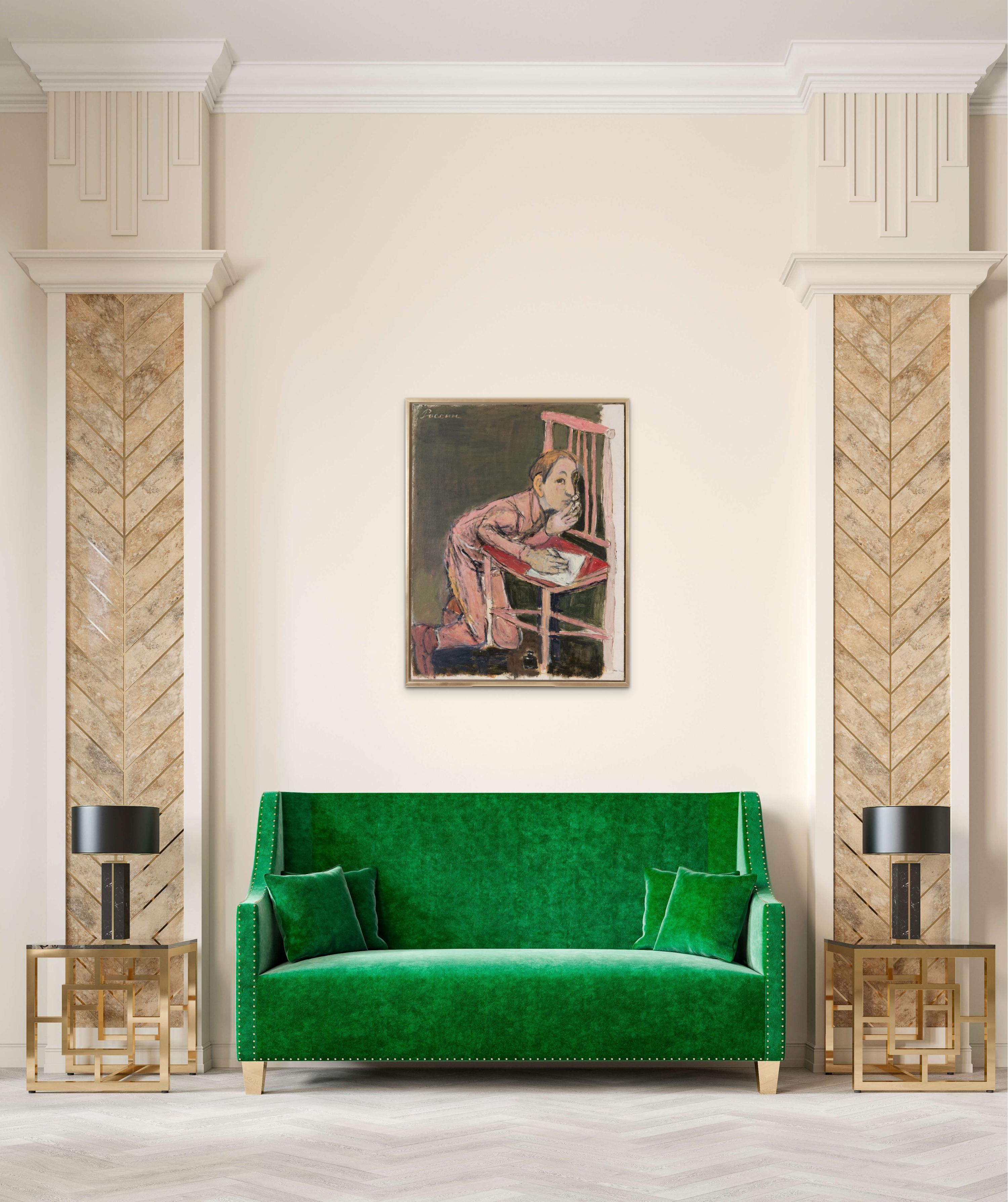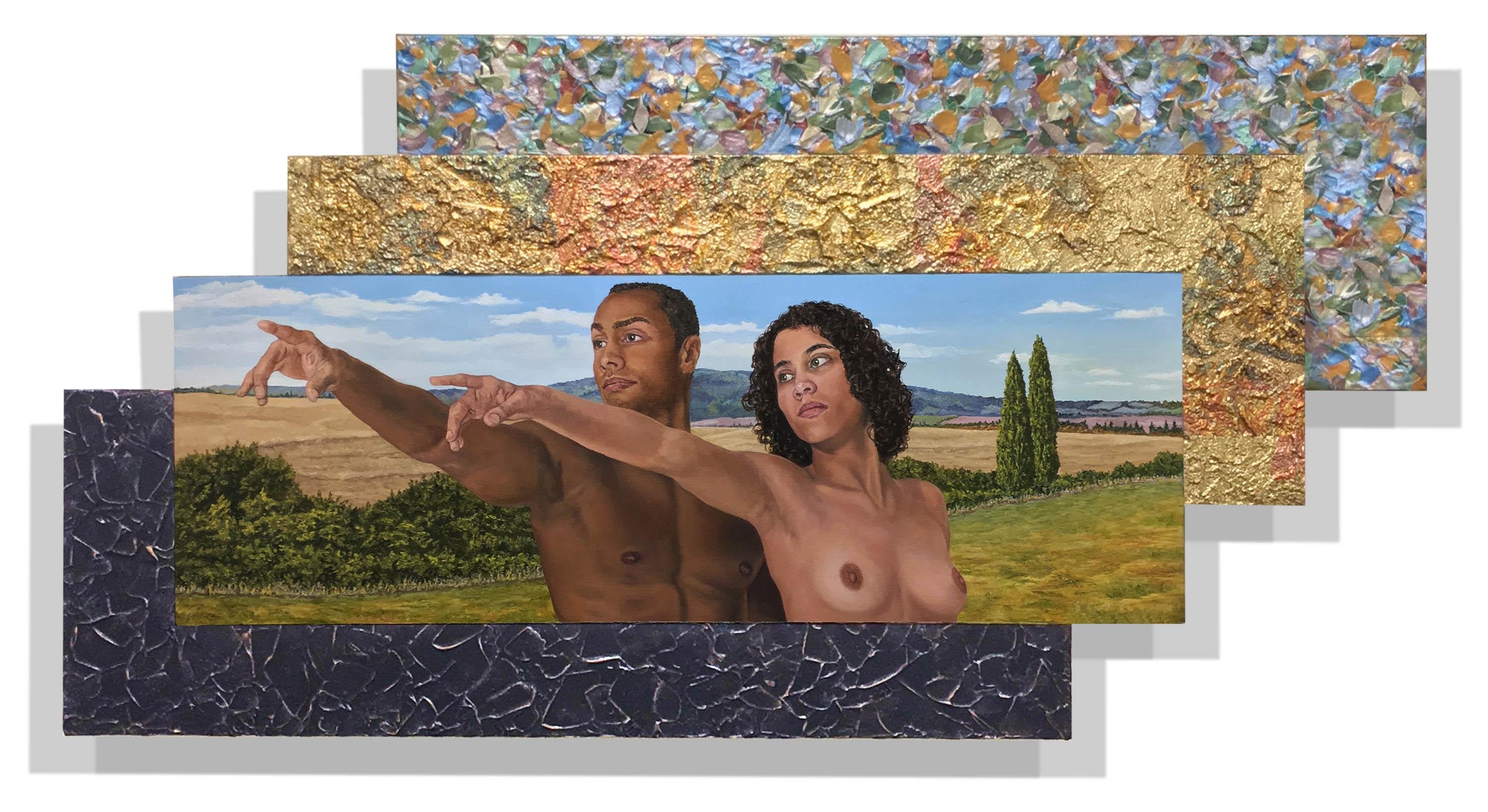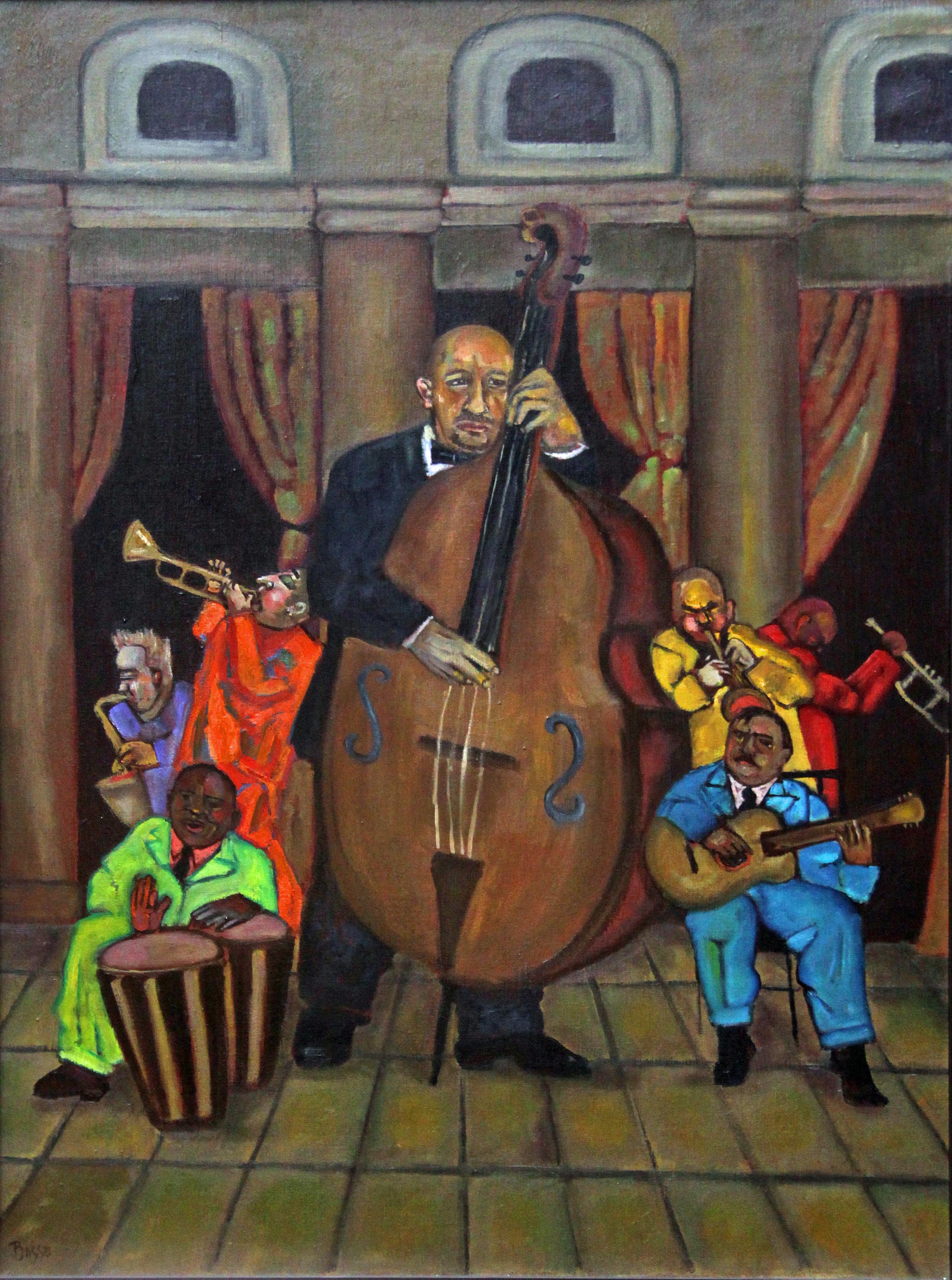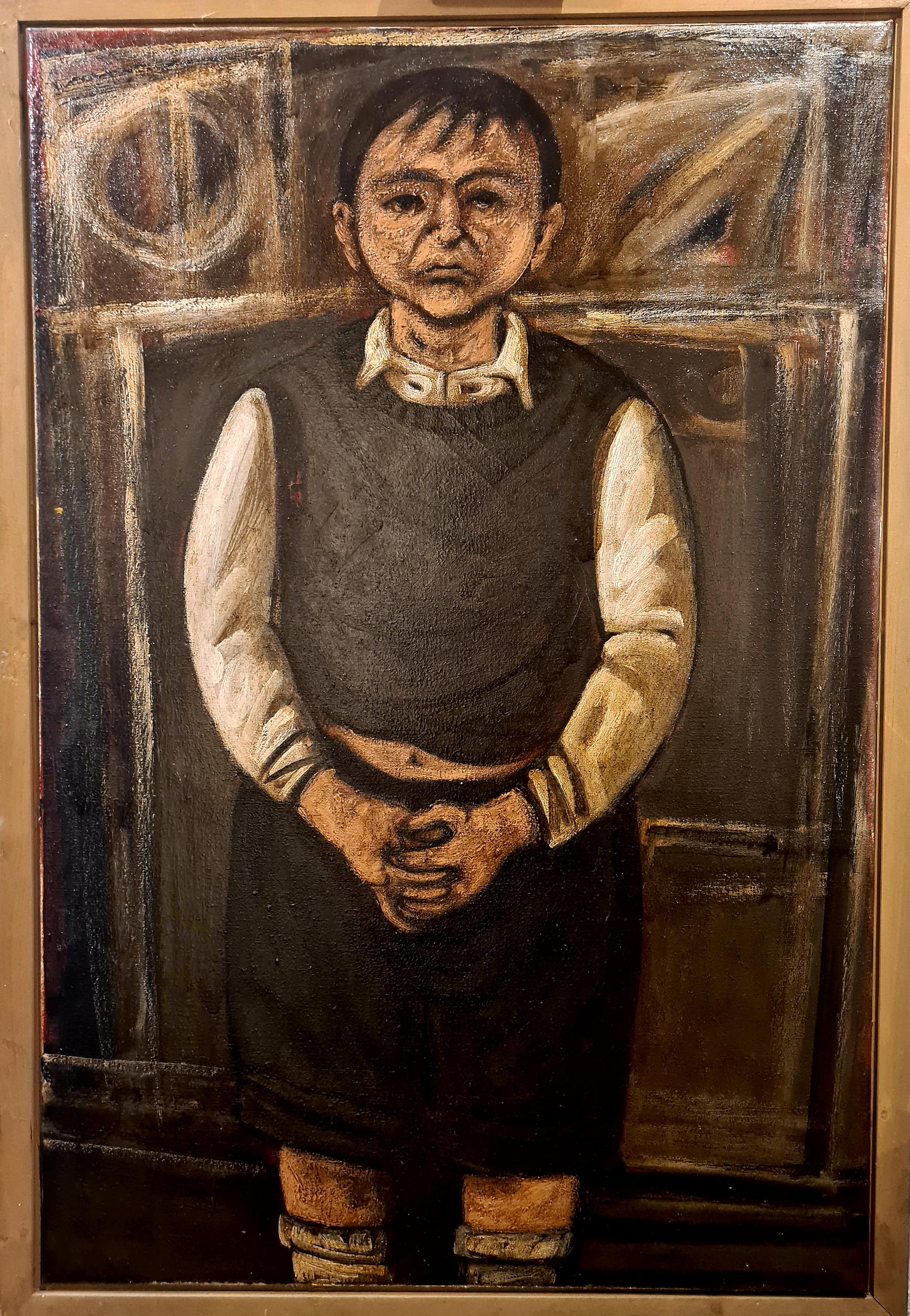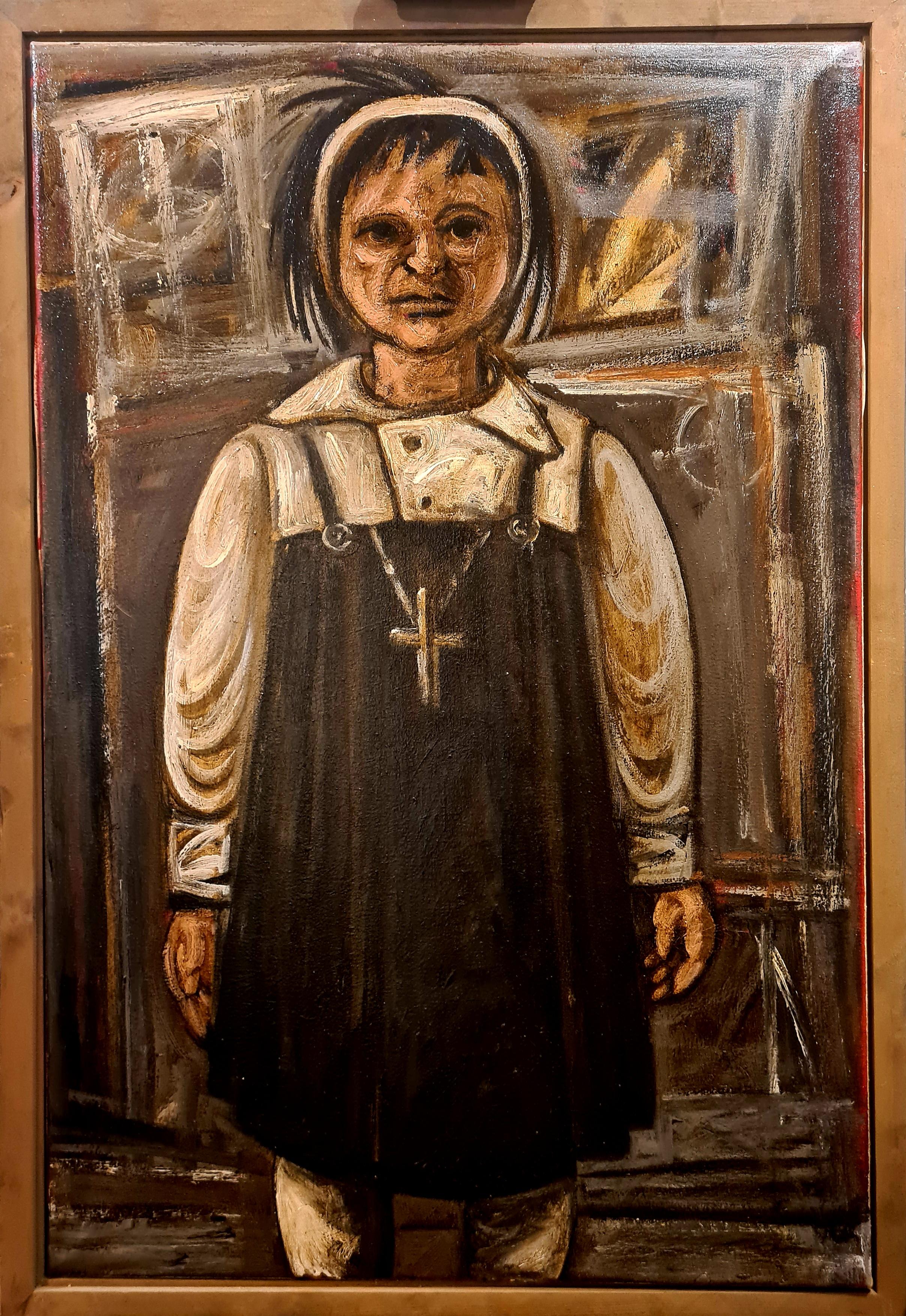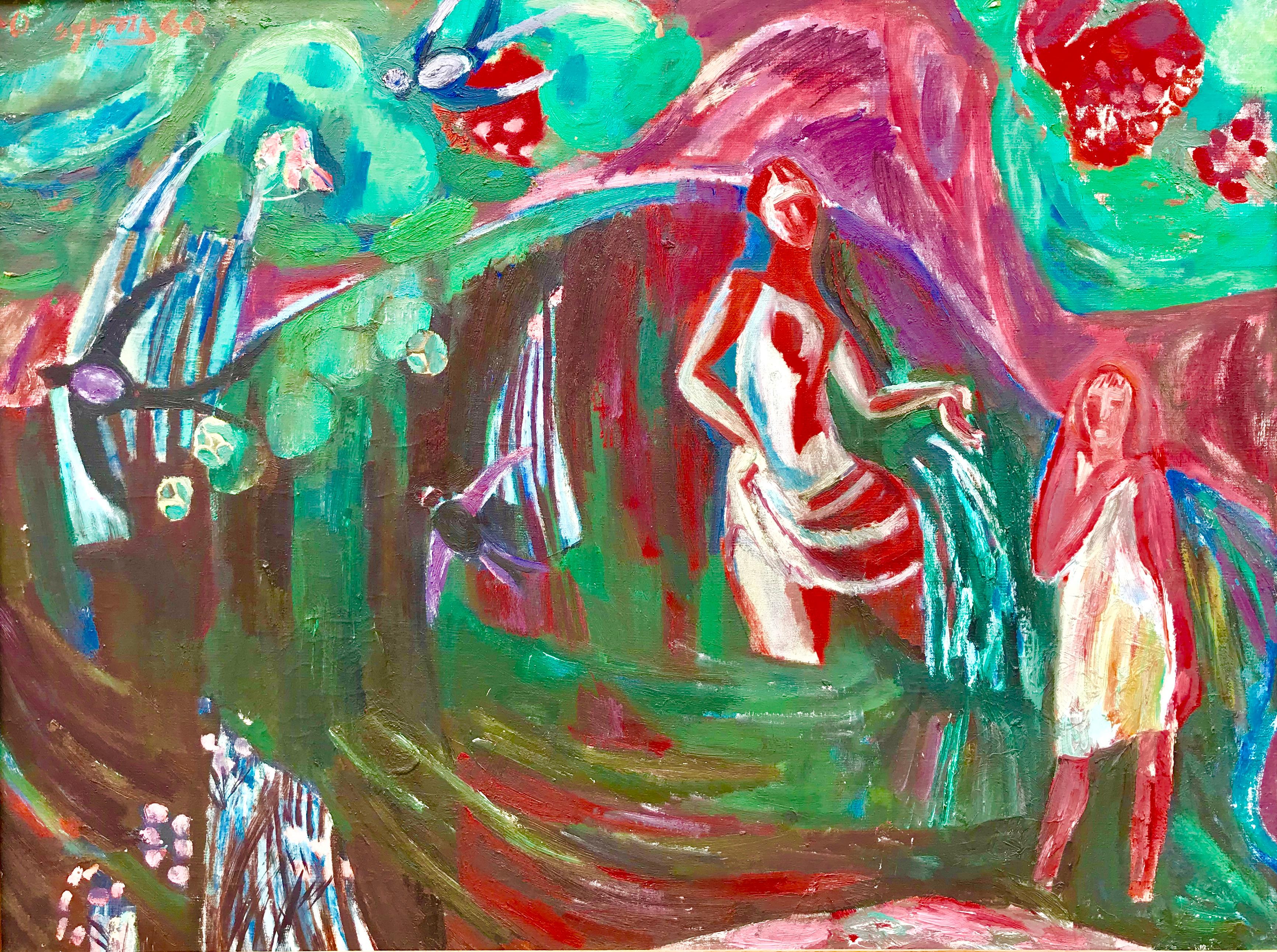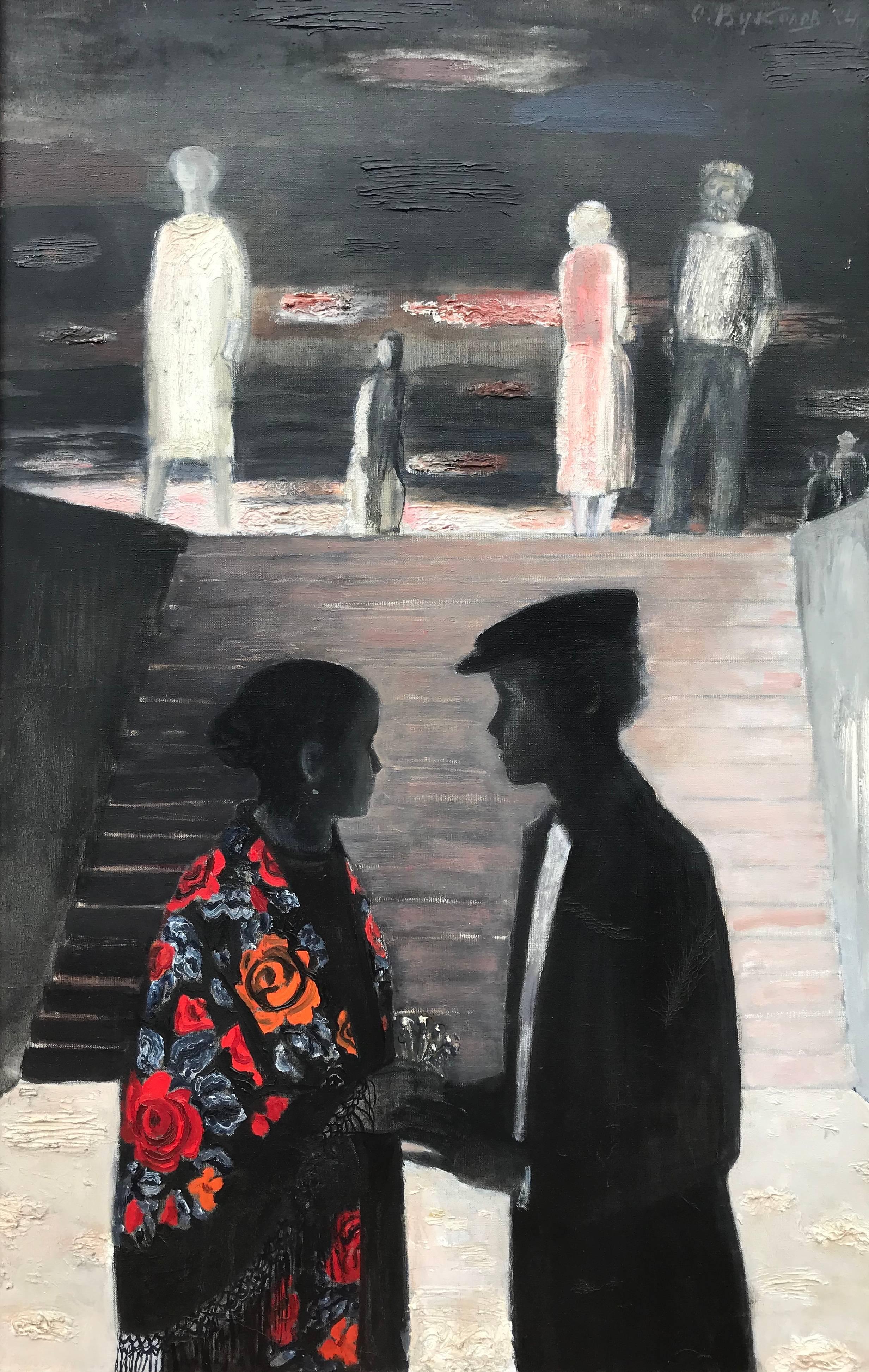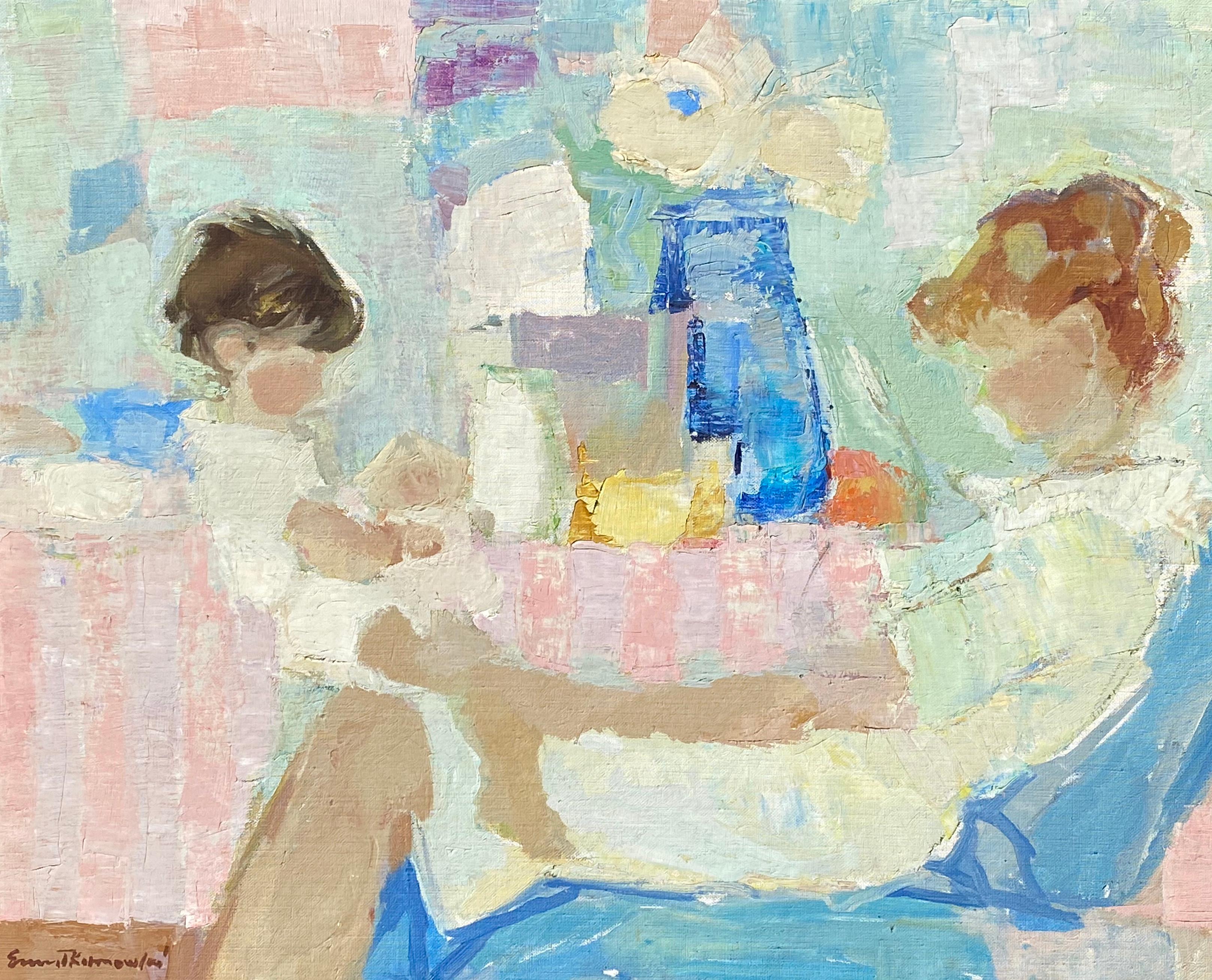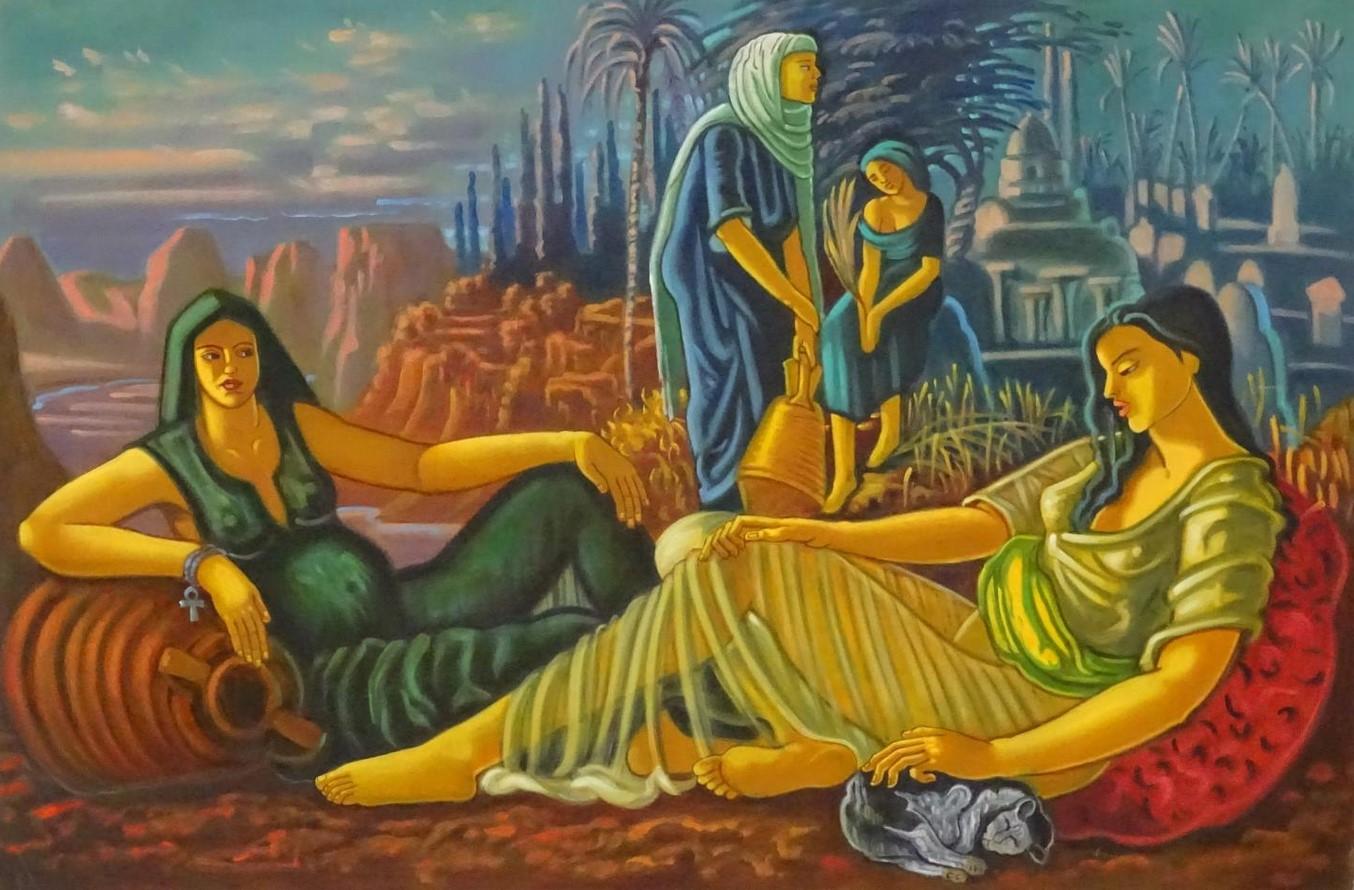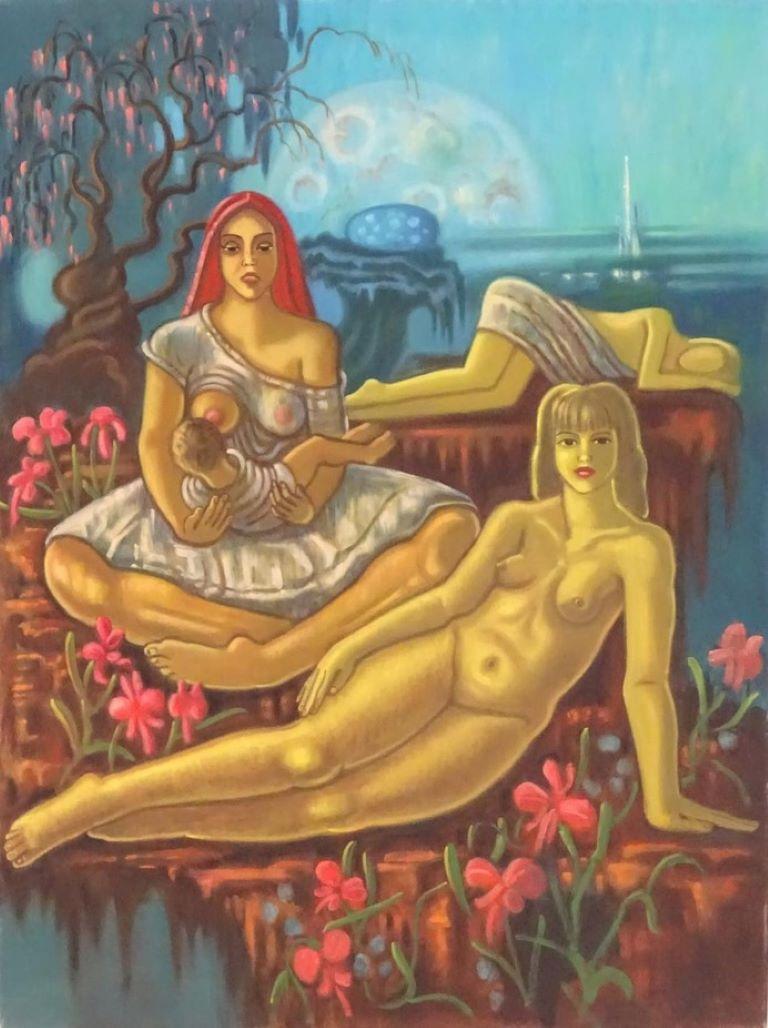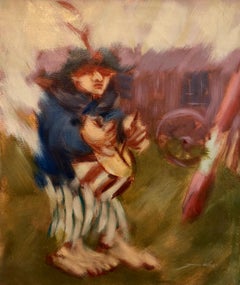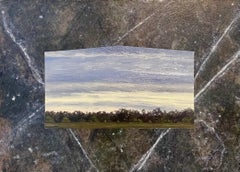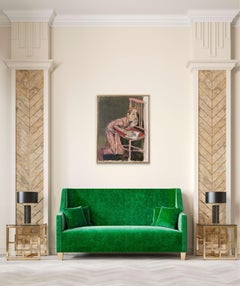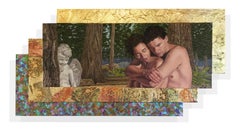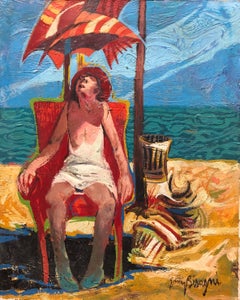
Woman in Chair Beach Scene Italian Modernist Oil Painting
View Similar Items
Want more images or videos?
Request additional images or videos from the seller
1 of 10
Getty BisagniWoman in Chair Beach Scene Italian Modernist Oil Painting
About the Item
- Creator:Getty Bisagni (1931, Italian)
- Dimensions:Height: 20 in (50.8 cm)Width: 16 in (40.64 cm)
- Medium:
- Movement & Style:
- Period:
- Condition:unframed. minor wear.
- Gallery Location:Surfside, FL
- Reference Number:1stDibs: LU3823156071
About the Seller
4.9
Platinum Seller
These expertly vetted sellers are 1stDibs' most experienced sellers and are rated highest by our customers.
Established in 1995
1stDibs seller since 2014
1,549 sales on 1stDibs
Typical response time: 1 hour
More From This SellerView All
- Spanish Catalan Modernist Oil Painting Drummer Boy Figurative AbstractionBy Artur DuchLocated in Surfside, FLArtur Duch Puig, born 1951 in Sitges In 1971 he started studying at the St. Jordi School of Fine Arts in Barcelona. There he developed his artistic skills in the fields of sculptu...Category
20th Century Post-Modern Figurative Paintings
MaterialsCanvas, Oil
- French Modernist Post Impressionist Provence Mod Women Jean Sardi Oil PaintingLocated in Surfside, FLAttributed to Jean Sardi, French (b. 1947) Painting, Oil on Board "Seated Woman". Apparently not signed. Dimensions: Sight- 30.5" x 24.5", Frame- 31.25" x...Category
20th Century Post-Modern Figurative Paintings
MaterialsOil
- Julie Bozzi Americana Landscape Oil Painting Trompe L'oeil Frame Woman ArtistBy Julie BozziLocated in Surfside, FLJulie Bozzi (American, b. 1943) Hephaestus, 1989 oil on panel signed and dated (lower right) Provenance: Laura Carpenter Fine Art, Santa Fe The frame is just the panel painted in a f...Category
1980s Post-Modern Landscape Paintings
MaterialsOil, Panel
- Large Judaica Oil Painting, Polish Jewish Wedding in the Shtetl Chaim GoldbergBy Chaïm GoldbergLocated in Surfside, FLGenre: Judaica Subject: Architecture Medium: Oil Surface: Canvas Country: United States Dimensions: 40X60 inches Temple Chaim Goldberg -- born in the Polish shtetl of Kazimierz D...Category
20th Century Impressionist Figurative Paintings
MaterialsCanvas, Oil
- Large Pop Art Oil Painting "Pear" Modernist Colorful Composition Suzanne MearsLocated in Surfside, FLBold, colorful, still life oil painting of a pear. In lush, vibrant color. SUZANNE WALLACE MEARS During college she focused on painting and clay. Then it became photography and clay, then only clay, then kiln formed glass and today its kiln formed glass, painting and plasma cut steel sculpture. She also works in oil paint and encaustic. Reminiscent of the color works of Jim DIne and the fruit paintings of Tom Seghi. She never works with only one medium. She uses color and texture to create energetic, luminous, joyous works with the glass. Bright, bold color using reds, blues, oranges reflect my travels in color saturated countries such as Tibet, Nepal, China and Mexico. At random I use solid color fields as a challenge to my driving love of vibrant color. Her favorite themes are inspired by nature and antiquity. Kiln formed glass uses flat sheets of glass which are cut into shapes, layered and incorporate accessory elements of frits, copper wire and mesh, pieces of sheet copper or brass and dichroic glass fired in a kiln. EDUCATION BA, University of Iowa, Iowa City, Iowa, 1964 Graduate School, 44 hours, double major Summer School University of Wisconsin, Madison, Wisconsin 1963 Master Class, Patty Gray Instructor, tde Glass Furnace, Turkey Master Class, Richard La Londe...Category
20th Century Pop Art Abstract Paintings
MaterialsCanvas, Oil
- Large Naive European Folk Art Oil Painting Jovan Obican Klezmer Jazz MusicianBy Jovan ObicanLocated in Surfside, FLGenre: Other Subject: People Medium: Oil Surface: Canvas Dimensions: 35" x 16.5 Dimensions w/Frame: 35.5" x 17.25 This depicts a Jazz or Klezmer musician. This one is a banjo or guitar player. The last photo shows it in a group of three that I have available. This listing is for the one painting. The artist Jovan Obican iconic style is child-like yet masterfully adult; a style that tells a story with sociological overtones. His funny little people are always colorful, full of spirit, living with music and birds to bring them happiness. JOVAN OBICAN Cannes, France, b. 1918, d. 1986 Jovan Obican (1918-1986) artist, painter, sculpture and mosaic ceramic artisan was born in Cannes, France, to his Yugoslavian parents. From childhood on, Jovan practically devoted himself to art, scratching designs into the dirt when paper was unavailable. He trained with many recognized teachers and with many styles. He finished his training, imbued with the spirit of his native country, the people, their legends, and their philosophy. It has been said that his work has a "timeless quality" and a naive, folk art, outsider art brut quality, child-like primitive style. Obican is identified with his style the world over, a style that is simple yet sophisticated; child-like yet masterfully adult; a style that tells a story with psychological, philosophical or sociological overtones. His funny little people are always colorful, full of spirit, living with music and birds to bring them happiness. Best known for his depictions of folklore and traditional costumes rendered in a playful, childlike style and for his happy Jewish wedding scenes. He often used bright colors and black outlines in his renderings of figures and animals, giving his work an illustration-like quality. Thematically, the artist’s work is similar to Marc Chagall and Jean Dubuffet for its dreamlike images and so-called naïve style of painting. Over the course of his career, the artist maintained a studio in Boca Raton, Florida and Dubrovnik, Croatia—part of former Yugoslavia— where he developed an interest in Eastern Europe’s Jewish culture. Many of his mature works depict Jewish traditions and ceremonies, including traditional Jewish weddings, the dancing of the Hora, and traditional music. There is a display of his works in his former Dubrovnik studio. His style is a unique conglomerate of tradition, history, legends, heroes, old customs and folklore. It is a self-standing style, recognizable, cheerful, whimsical and a happy creation. Naïve art is any form of visual art that is created by a person who lacks the formal education and training that a professional artist undergoes (in anatomy, art history, technique, perspective, ways of seeing). Unlike folk art, naïve art does not necessarily evince a distinct cultural context or tradition. Naïve art is recognized, and often imitated, for its childlike simplicity and frankness. Paintings of this kind typically have a flat rendering style with a rudimentary expression of perspective. One particularly influential painter of "naïve art" was Henri Rousseau (1844–1910), a French Post-Impressionist who was discovered by Pablo Picasso. Naïve art is often seen as outsider art that is by someone without formal (or little) training or degree. While this was true before the twentieth century, there are now academies for naïve art. Naïve art is now a fully recognized art genre, represented in art galleries worldwide. Museums devoted to naïve art now exist in Kecskemét, Hungary; Riga, Latvia; Jaen, Spain; Rio de Janeiro, Brasil; Vicq France and Paris. "Primitive art" is another term often applied to art by those without formal training, but is historically more often applied to work from certain cultures that have been judged socially or technologically "primitive" by Western academia, such as Native American, sub saharan African or Pacific Island art (see Tribal art). This is distinguished from the self-conscious, "primitive" inspired movement primitivism. Another term related to (but not completely synonymous with) naïve art is folk art. There also exist the terms "naïvism" and "primitivism" which are usually applied to professional painters working in the style of naïve art (like Paul Gauguin, Mikhail Larionov, Paul Klee). At all events, naive art can be regarded as having occupied an "official" position in the annals of twentieth-century art since - at the very latest - the publication of the Der Blaue Reiter, an almanac in 1912. Wassily Kandinsky and Franz Marc, who brought out the almanac, presented 6 reproductions of paintings by le Douanier' Rousseau (Henri Rousseau), comparing them with other pictorial examples. However, most experts agree that the year that naive art was "discovered" was 1885, when the painter Paul Signac became aware of the talents of Henri Rousseau and set about organizing exhibitions of his work in a number of prestigious galleries. The Earth Group (Grupa Zemlja) were Croatian artists, architects and intellectuals active in Zagreb from 1929 to 1935. The group included the painters Krsto Hegedušić, Edo Kovačević, Omer Mujadžić, Kamilo Ružička, Ivan Tabaković, and Oton Postružnik, the sculptors Antun Augustinčić, Frano Kršinić, and the architect Drago Ibler. A term applied to Yugoslav (Croatian) naive painters working in or around the village of Hlebine, near the Hungarian border, from about 1930. Some of the best known naive artists are Dragan Gaži, Ivan Generalić, Josip Generalić, Krsto Hegedušić, Mijo Kovačić, Ivan Lacković-Croata, Franjo Mraz, Ivan Večenaj and Mirko Virius. Camille Bombois (1883–1970) Ferdinand Cheval, known as 'le facteur Cheval' (1836–1924) Henry Darger (1892–1973) L. S. Lowry (1887–1976) Grandma Moses, Anna Mary Robertson (1860–1961) Nikifor (1895–1968) Poland, Horace Pippin (1888–1946) Jon Serl (1894-1993) United States Alfred Wallis (1855–1942) Scottie Wilson (1890–1972) Gesner Abelard (b. 1922) Jan Balet (1913–2009) Michel Delacroix (b. 1933) France Howard Finster (1916–2001) Ivan Rabuzin (1921–2008) Spontaneous Art Museum in Brussels Art en Marge Museum in Brussels MADmusée in Liege International Museum of Naive Art of Brazil...Category
20th Century Folk Art Figurative Paintings
MaterialsCanvas, Oil
You May Also Like
- A DesignerLocated in Zürich, ZHSOLOMON ROSSINE (*1937) was born in Gomel, Belarus. He is one of the prominent artist of Leningrad underground artistic movement. Solomon Rossine aspires to understand the drama of the Russian history...Category
2010s Post-Modern Figurative Paintings
MaterialsOil, Canvas
- Jack Reilly, Adam and Eve in Tuscany, 2017Located in Santa Monica, CAOil, acrylic polymers, grout, gold leaf, on shaped canvas.Category
21st Century and Contemporary Post-Modern Figurative Paintings
MaterialsSilver, Gold Leaf
- Jack Reilly, Lysander and Hermina, Enchanted in the Forest, 2018Located in Santa Monica, CAOil, acrylic polymers, grout, gold leaf, on shaped canvasCategory
21st Century and Contemporary Post-Modern Figurative Paintings
MaterialsSilver, Gold Leaf
- The Dust Collector religious theme female figure ceremonial objects, bright redsBy Stephen BassoLocated in Brooklyn, NYoil on linen canvas heavy duty stretcher reference to Hatian vessels named govi containing souls of the departedCategory
2010s Post-Modern Figurative Paintings
MaterialsCanvas, Oil
- El Bajo Latin music theme rich vibrant colors musical instruments strong rhythmBy Stephen BassoLocated in Brooklyn, NYoil on linen canvas There is no charge for a beautiful gold rimmed ebony colored wood frame, which is included with this painting . the dimensions 52 x 38 are including this frame a...Category
2010s Post-Modern Figurative Paintings
MaterialsCanvas, Oil
- 'Him', A Large Glasgow School Oil Painting Portrait on CanvasLocated in Cotignac, FRA large Glasgow School oil on canvas portrait by Scottish artist Stuart Mackenzie. The painting is presented in a plain baton wood frame. Though not ...Category
Late 20th Century Post-Modern Figurative Paintings
MaterialsCanvas, Oil
